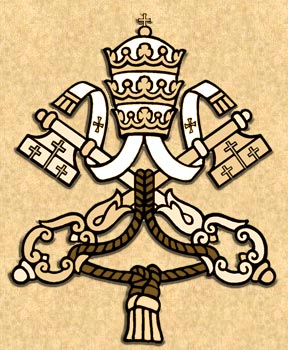Saint Lidwina (Lydwine) lived in Schiedam (Holland). We know a lot about her thanks to many books, including a book about her written by J.K. Huysmans (translated by Agnes Hastings. into English) and reprinted by Tan Books and Publishers of Rockford, IL., in 1979).
The original work is dated 1923 and was published in French.The preface of this work reveals that Jan Gerlac, the sacristan of the Augustinian Monastery of Windesem, was a relation of
hers and he lived a number of years near Lidwina (later in the same house as Lidwina) and thus writes from personal observation and was quoted by Huysmans.
Two other gentlemen are quoted his book. One of these is Thomas à Kempis who was subprior of the Augustinians of Mount Agnes near Zwolle. We know à Kempis as the author of the Imitation of Christ. Lidwina lived in Holland at the time of the Great Schism when the Church was split due to two anti-popes.
At the age of 15 Lidwina broke a rib while ice skating and remained bedridden for the rest of her life. She put her illness to a supernatural purpose. She was suffering voluntarily for the welfare of the Church. She fasted during this entire time when she was bedridden and was found often in ecstacy. She is one of the most heroic victim-souls of all time.
During her lifetime, there was a school of ascetics in Deventer that followed the teachings of Blessed Jan van Ruysbroeck, who preached at Campen, Zwolle, Amsterdam, Leiden, Zutphen, Utrecht, Gouda, Haarlem and Delft. He and his pupil, Florent Radewyns, a Deventer priest, founded the aforementioned Institute of Brothers and Sisters of Communal Life. This order, although it never bore that name, were really oblates of Saint Augustine.
It is interesting to note that the name Lidwina a formalization of Lidie comes from the Dutch word "lijden" which means to suffer. The aid of physicians were enlisted by Lidwina's parents to seek a cure for her disease. She was in intense pain, sobbed on her bed in a state of terrible abandonment, was given to constant vomiting, suffered burning fevers and could not hold down food of any kind. This situation lasted for three years.
Then followed a relatively blissful period but she was still confined to bed and could not get up. In the following years she still suffered greatly from abscesses, inflamed sores, and
it was said she was near death twenty-two times. At the age of 28, the coldest winter ever experienced in Holland set in, when even the fish froze in the rivers, the tears she shed at night froze to her face.
From the Third Order of Saint Francis in Schiedam she received a woolen shirt to wear, however she was not a member of that lay order. Historically, at that time William VI, a duke, was the Count of Holland. As he traveled with his wife, the Countess Marguerite through Schiedam, he granted Lidwina's father, who had fallen on bad times free rent on the premises they occupied. In the 13th and 14th Century, Holland began to see some economic development and William was proclaimed German king in 1247.
There was yet another war, the 100-Year War, but also during that time a number of cities obtained municipal rights, as Hecht already mentioned but also Middelburg, Dortrecht, Delft, Leiden, Haarlem, Arnhem, Nijmegen, Zutphen, Deventer and Kampen obtained municipal privileges. According the Encyclopediae Britannica: "The rise of the towns was accompanied by their struggle for political influence in their respective territories, in which they co-operated with the nobility and the clergy. This led to the growth of representative assemblies which were to become essential political institutions."
Returning to the story of Saint Lidwina, she continued to suffer and the more she suffered, apparently, the more she was given God's Gift of contemplation and bilocation. She was given to be in two places at once, when Jesus asked her to be with him at Golgotha. In answer to His request, Lidwina replied: "O Saviour, I am ready to accompany you to that mountain and to suffer and die there with you!" (Huysmans, 1923)
"He took her with Him, and when she returned to her bed, which corporeally she had never left, they saw ulcers on her lips, wounds on her arms, the marks of thorns on her forehead and splinters on her limbs, which exhaled a very pronounced perfume of spices." A number of miraculous healings were reported. For example, Lidwina prayed for a woman, a friend of hers, who had a frightful toothache. The woman's pain ceased immediately. Also, another woman came to her to ask for her intercession for her child who was screaming with pain. When the child was placed on Lidwina's bed his troubles disappeared. When the child grew up, he became a priest in memory of Lidwina.
Additional miracles continued after her death and she is not forgotten. Her feast day occurs on April 14th.
Evil triumphs when good men do nothing - Edmund Burke
Tuesday, April 14, 2009
Subscribe to:
Post Comments (Atom)









No comments:
Post a Comment